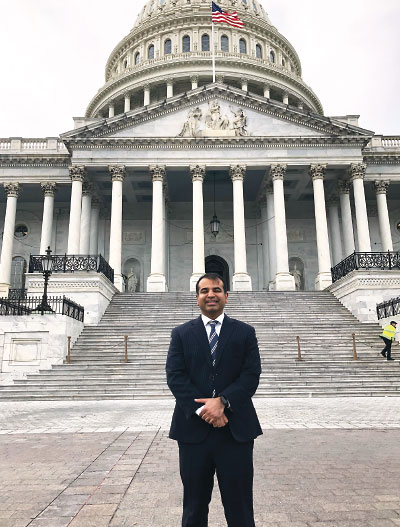In October 2022, over 130 health organizations, including APA, asked President Joe Biden to declare a national emergency in children’s mental health. “We urge you to treat the youth mental health crisis as the national emergency it continues to be,” the organizations
wrote in a letter.
Medical groups, schools, and advocacy organizations have been raising the alarm about the ongoing crisis in youth mental health, which was only exacerbated by the COVID-19 pandemic. New research shows that emergency department (ED) visits for suicidal ideation have been on the rise since before the pandemic, and suicide among youth may be linked to lack of access to care.
“We are increasingly seeing studies that make a strong case for big policy interventions,” said Anish Dube, M.D., M.P.H., chair of APA’s Council on Children, Adolescents, and Their Families. Those policies must take a public health approach, though. Even if the number of child and adolescent psychiatry fellowship slots doubled tomorrow, he said, there would still be a shortage in the near future. He pointed to the Collaborative Care Model as an opportunity to more quickly increase access to child and adolescent psychiatrists in communities across the country.
“The current generation of youth has gone through a lot in the past three to four years,” Dube said. “There is a lot of increased pressure on young people to try to figure out how to succeed in a rapidly changing world, and I think for many of them the future is uncertain.”
Suicidal Ideation ED Visits Increasing Before Pandemic
A
study published last November in
Pediatrics analyzed Illinois hospital administrative data for ED visits coded for suicidal ideation for youth aged 5 to 19 years. Audrey Brewer, M.D., M.P.H., and colleagues compared visit rates across three 22-month periods: January 2016 to October 2017, November 2017 to September 2019, and October 2019 to June 2021. They specifically analyzed how the COVID-19 pandemic impacted ED visits by comparing data from fall 2019 with data from fall 2020. Brewer is an instructor of pediatrics at Northwestern University Feinberg School of Medicine and an attending physician in the Division of Advanced General Pediatrics and primary care at the Ann & Robert H. Lurie Children’s Hospital in Chicago.
In total, Brewer and her colleagues analyzed 81,051 ED visits at 205 Illinois hospitals. Visits for suicidal ideation accounted for $785 million in charges and 145,160 days in the hospital over 66 months. Further, ED visits for suicidal ideation increased 59% from the 2016-2017 study period to the 2019-2021 study period. There were significant spikes in the number of visits during both the fall of 2019 and the fall of 2020. Youth aged 14 to 17 had the highest frequency of monthly visits.
While ED visits related to suicidal ideation did not greatly differ between the fall of 2019 and fall of 2020, there was a significant increase in hospitalizations through the ED during the fall of 2020. The authors posited that this could indicate that patients had more severe symptoms during the pandemic.
“The data is humbling to me,” Brewer told Psychiatric News. “It’s important that we think about what people have gone through, what they continue to go through, and how families are dealing with what’s happening with their kids.”
Brewer and her colleagues noted in the study that the results are likely mirrored throughout the rest of the country. Illinois is a large, diverse state, with both rural and urban populations.
The potential causes of the increase are likely multifactorial, Brewer said, and she pointed out the systemic factors that impact the mental health concerns of racial and ethnic minority youth.
“Youth who live in communities that may face gun violence on a daily basis or poverty may need different interventions than other youth,” she said. “We need to think more about how historical and structural racism and discrimination may play a role in these outcomes.”
Lack of Mental Health Professionals Linked With Youth Suicides
A
study published in
JAMA Pediatrics by Jennifer Hoffmann, M.D., M.S., and colleagues last November illustrates just how strong the association is between lack of access to mental health professionals and the increased risk of suicide among youth. Hoffmann is an assistant professor of pediatrics at Northwestern University Feinberg School of Medicine and an attending physician in the Division of Emergency Medicine at the Ann & Robert H. Lurie Children’s Hospital in Chicago.
Hoffmann and colleagues analyzed data from the Centers for Disease Control and Prevention on suicide deaths among youth aged 5 to 19 years from 2015 to 2016. They then looked at counties that are considered mental health professional shortage areas, which the U.S. Health Resources and Services Administration designates based on the number of mental health professionals relative to the overall population, the area’s level of need for mental health services, and the availability of services in contiguous areas. Of the 3,150 counties in the country, 16 were excluded because they had fewer than 100 children aged 5 to 19, and one was excluded due to missing data.
The annual youth suicide rate in counties with mental health professional shortage area designations was 5.09 per 100,000 youth, compared with 3.62 per 100,000 in counties with partial or no designation. The youth suicide rate decreased as the number of practicing child psychiatrists increased, and the rates were lower in counties with a children’s mental health hospital. The authors also found that youth suicide by firearm occurred more often in counties with shortages of mental health professionals. In total, 68% of counties included in the study were designated as mental health professional shortage areas.
While mental health professional shortages are widespread across the country, the authors also found that they are more severe in rural areas, in communities with lower household incomes, and in areas with lower educational attainment, Hoffmann explained. “Unfortunately, these are the very same communities where children are more likely to experience poor mental health outcomes,” she said.
Addressing the Shortage Through Policy
Hoffmann’s study underscores the need for federal investments to bolster the pediatric mental health workforce, she said.
There are several bills pending in Congress that would make such investments. The Investing in Kids’ Mental Health Now Act (S 4747) would incentivize states to increase Medicaid reimbursement for mental health and substance use disorder treatment services for youth, providing direct support to the pediatric mental health workforce and improving access to children’s mental health care.
Having more mental health professionals in a community not only has obvious benefits in that more children can receive the services they need, Dube said, but it also helps to normalize mental health services for youth in the community as a whole. “Child and adolescent psychiatrists aren’t just seeing individual patients,” he said. “We are embedded in the communities through schools or community groups or even religious organizations. It has the larger effect of bringing mental health into regular conversations.”
Hoffmann’s study was supported by an Academic Pediatric Association Young Investigator Award. Brewer’s study received no outside funding. ■

